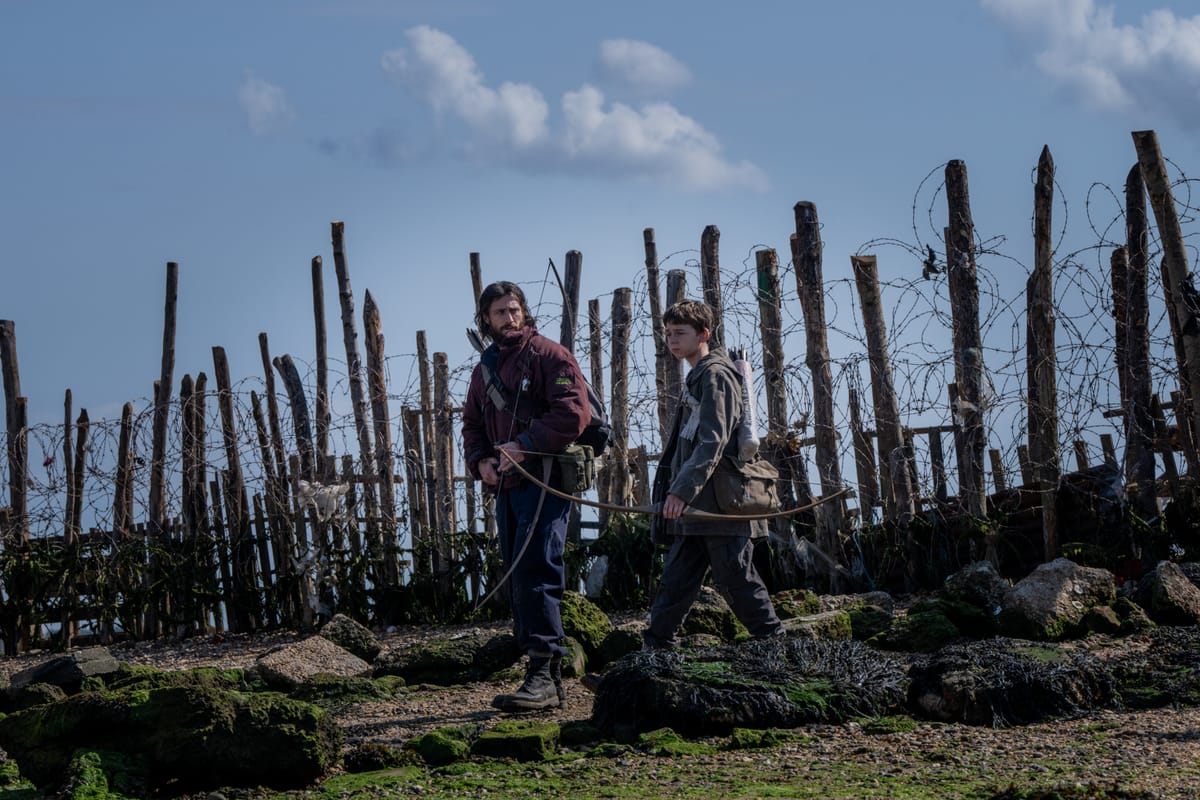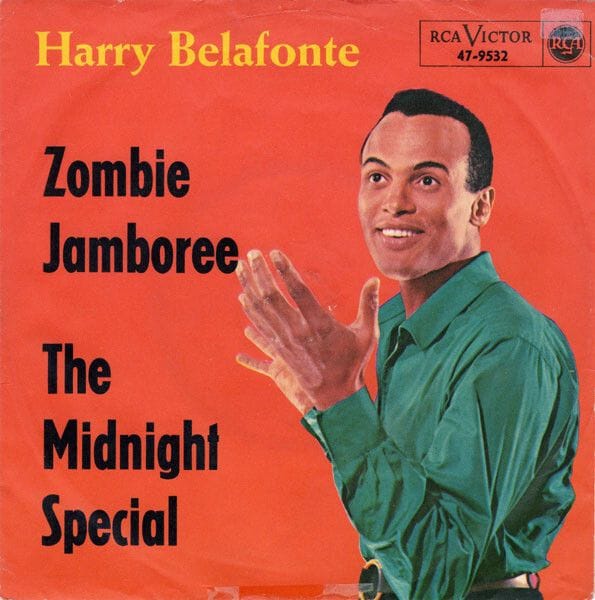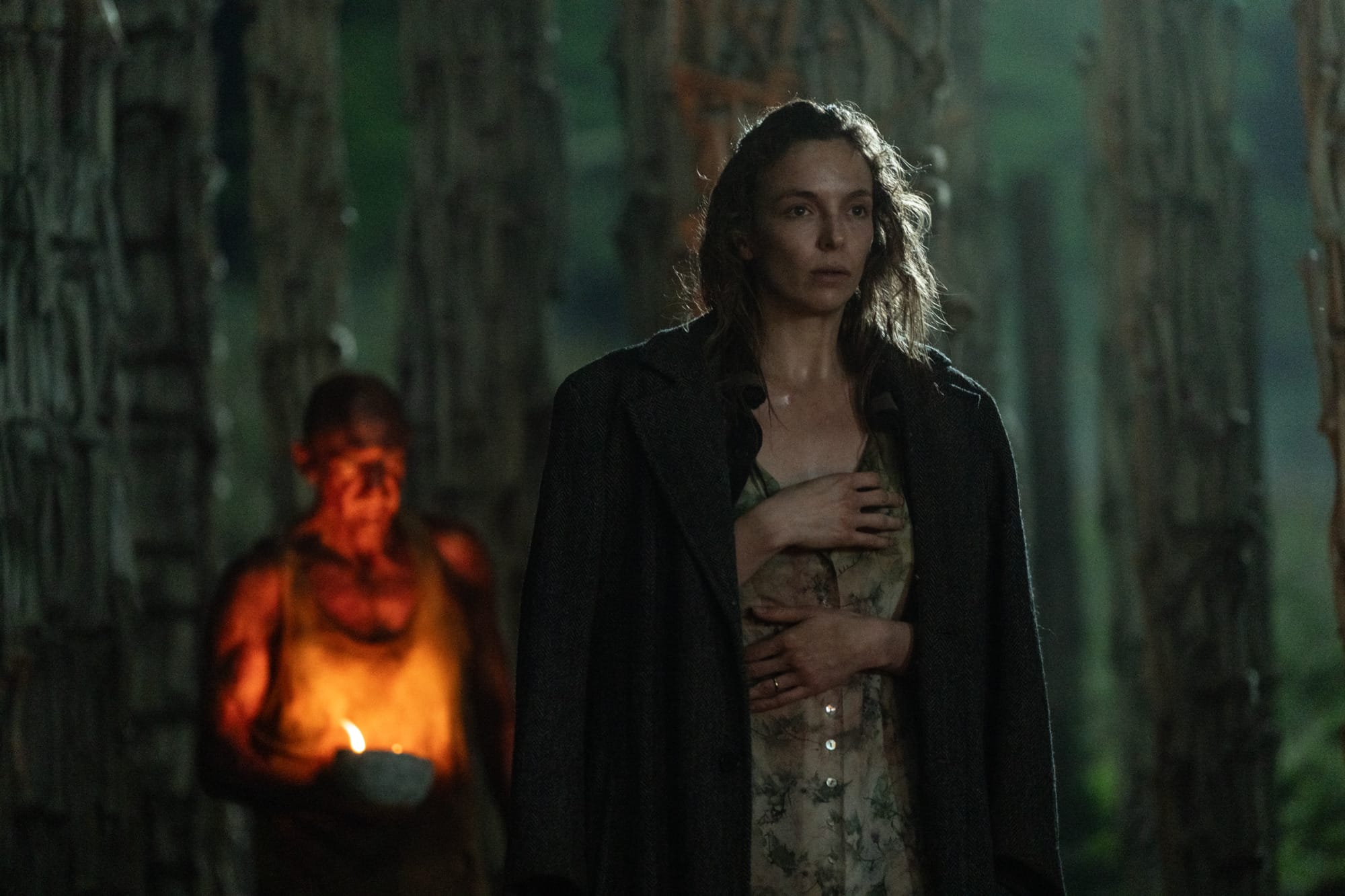It Was A Zombie Jamboree: "28 Years Later," and snatches in the L.A. streets

Dodging the infected onscreen; dodging the thugs in Santa Monica
A lot of world leaders talkin' 'bout war
And I'm afraid they're going too far
So it's up to us, you and me
To put an end to catastrophe
We must appeal to their goodness of heart
And ask them to pitch in and please do their part
'Cause if this atomic war begin
They won't even have a part to pitch in
And we'll be singing
Back to back, belly to belly
Don’t give a damn, done dead already
At the zombie, zombie jamboree
“Zombie Jamboree”—Harry Belafonte version

This blog post will in due course find its planned topic in giving a compact account of the highly enjoyable, if hardly life-changing, virtues of “28 Years Later” as created by filmmakers Danny Boyle (directing) and Alex Garland (screenplay. But—and call it a half-twist if you like—when the above headline suggested itself, it was a quick entrée to the above lyric, inserted by the great entertainer and activist Harry Belafonte as a variation on a classic calypso song, which impressed itself upon me during casual listening sessions in my parents’ suburban New Jersey home. (When it might be found, on the 1962 LP, “The Many Moods of Harry Belafonte,” among various crooner albums and, in a somewhat raucous competing cover version, on 1959’s “String Along with the Kingston Trio.”
So, will this stand as yet another Dogtown post that yields messaging territory to the many ongoing depredations upon capital-D Democracy as (mal)practiced by Donald J. Trump? Yes, because no matter where and how you grew up, if you have an empathetic heart and any sort of raised consciousness about our nation’s present and future (as Elvis Costello sang in “Less Than Zero,” “now we’ve put the past away”), we’re facing up to an administration run amok.
This is not the place to ponder the possibly shifting sands of Iran and Israel’s (putative, but unconfirmed at this writing) agreement to a cease-fire following exchanges of missiles and (American-supplemented) bombs. Damage to our nation’s constitutional process from Trump going solo on throwing in our bunker busters is a pesky sidebar issue.)
If the cease-fire becomes Trump’s shiny object, even as his grandiose bragging about bunker-busting is debunked, what of life on the ground in our streets?
It was 1984, deep into the Reagan presidency (Elon Musk was 12), when Elvis Costello’s “Peace in Our Time” bemoaned the “international propaganda star wars” that meant, “There's already one spaceman in the White House/What do you want another one for?”
He would conclude in a lyric that took in America’s misbegotten policies as well as those of the United Kingdom stretching from Neville Chamberlain to Margaret Thatcher:
There’s a man goin’ round takin’ names
No matter who you claim to be
As innocent as babies
A mad dog with rabies
You’re still a part of some conspiracy
Meanwhile there’s a light over the ocean
Burning brighter than the sun
And a man sits alone in a bar and says, “Oh God, what have we done?”
I was in not a bar, but in my own car, on June 20, when that Costello lyric came back to me. I was driving east on Ocean Park Boulevard in Santa Monica, and about to cross 11th—that venerable north-south dodge that’s familiar to Angelenos who once owned “L.A. Shortcuts”--when I passed a scene right out of our expanding national zombie-takeover movie. At a glance, as I zipped uphill, out my side window I saw a trio of flak-jacketed brown shirts (or was it olive drab?) shoving a young male against the side of a small Japanese sedan as they flex-tied his wrists behind his back. That’s all I glimpsed, because when I flipped around to try to grab some video, their unmarked car that had forced the target vehicle off the roadway was gone. Their detainee was gone with them; left to their own devices—and future?--were a couple of shadowy figures in the sedan that sat perched on the roadside with its driver-side door still jerked open.
It all felt quite personal, even more so than the day before when I’d chatted with a friend who had just run a citizen’s mission that I would not have predicted for L.A., June 2025—he had just driven to a nearby district to pick up his longtime housekeeper, who dared not climb aboard a city bus that normally would have conveyed her to the work that might just support her children, including the daughter who’s in a state university college grinding for a medical degree. (Indeed, L.A.’s Metro system reports a substantial drop in ridership,)
So now we live waiting for the working class in California, so many them of color, to be chased down and corralled by—what else can you compare these masked and anonymous thugs to but…zombies?
It’s so obvious the cruelty is the point.
We have to keep reminding Stephen Miller and his thug army that we know that, we see that. They simply want to stir up satisfied hate and support in the base.
The cruelty is the point.
Try to tell me it’s not.
I almost wrote, here endeth the lesson, but let’s bring Mr. Belafonte back onstage. He died in April of 2023, aged 96, but this robust activist and patriot whose dear friend and frequent guest in Manhattan was Dr. Matin Luther King. Belafonte, born in Harlem to West Indian immigrants, once absorbed a rebuke from his endorsements sponsor Revlon when…wait for it—he touched conspicuously white Petula Clark’s wrist during a televised duet in 1960.
He survived in his exemplary activism, even through his latter days. Here’s what he wrote in a New York Times Op-ed on Election Day 2016, in a last try at staving off the rise of the “feckless and immature” Trump. Belafonte sought to speak specifically to African-American voters:”“Mr. Trump asks us what we have to lose,” he wrote, “and we must answer: Only the dream, only everything.”
And yet, 2016 happened, and even worse (as we now fully know), so did 2020, whereupon Belafonte wrote: “We have learned exactly how much we had to lose — a lesson that has been inflicted upon Black people again and again in our history — and we will not be bought off by the empty promises of the flimflam man.”
Well, it happened anyway. If after Chernobyl blew up with killing airborne radiation pouring across continents, a French friend advised me not to buy a stash of herbes de Provence lest I ingest irradiated thyme, etc. Now in the wake of the Iran strikes, what are the chances of the globe escaping the current nuclear adventure as it is steered by a pack of contentious numb-nuts who spare us an accidental poisoning?
So, on to “28 Years Later” in all its gory glory. As the fourth in what promised to be at least a quintet of related works (a fifth, 2026’s “28 Years Later: The Bone Temple” is in the can; a sixth seemingly awaits the green light continuing success may bring.) The current release won lots of love from the critics, if only a middling embrace by audiences, and as it glides past its $70 million cost, is set to surpass the box office of its still somewhat cultish brethren.
There are many aspects of the production that check the intriguing boxes the filmmakers so effectively command. Garland (now 55) emerged with 1996’s novel “The Beach,” advanced from seeing acclaim for the resultant films starring Leonardo DiCaprio and found a new level of stature with his screenplay for Boyle’s “28 Days Later,” and got an Oscar nom for the screenplay for his own debut directorial feature, 2014’s “Ex Machina.” Garland’s work has continued strong with “Civil War” see this newsletter’s coverage:
https://www.dogtown.press/alex-garlands-cinema-of-entrapment/
…and “Warfare” (see this writer’s IndieWire feature):
https://www.indiewire.com/features/interviews/ray-mendoza-warfare-interview-ptsd-1235114280/
The duo has become a conjoined paragon of thoughtful and striking cinema.
Boyle, 68, has made an optimal partner since the pair’s first collaboration on “The Beach” in 2000, a directing job Boyle won via his tearaway cult classic, “Trainspotting” in 1996. Skilled in both gritty (the multi-nominated hit “Slumdog Millionaire” in 2008 and “127 Hours”, with directing and producing Oscar noms in in 2010), 2008 and lyrical (many moments in “28 Years Later”), Boyle has said, “There's a theme running through all of them…they're all about someone facing impossible odds and overcoming them.”
It's probably a misnomer to speak of Boyle’s blood-splashed cycle as “zombie” movies (though Garland, even in the knowledge that the “infected” in the films are not necessarily the typical “undead” that stalked cinemas since George Romero’s 1968 “Night of the Living Dead,” has “no feeling of offense” at the term). Garland and Boyles’ longtime go-to producer Andrew MacDonald, has cited Boyles’ almost unparalleled skill at creating films that are “realistic but also incredibly uplifting and joyful.”
Perhaps the most effective way to contemplate that assessment is to look briefly at the four exemplary performances that anchor the film. In order of appearance, we have:
Aaron Taylor-Johnson as Jamie, a battle-tested scavenger--with a knack for killing even the dreaded Alpha creatures who have evolved into powerful steroidal monsters such as the mighty (and mightily endowed) `Samson’. Steely and given to braggadocio, inadequately supportive of his dramatically sickly wife and entirely too harsh with his son, he makes one wonder if a star of his luster would take on the role without some promise for the character’s redemption in the next installment(s). It’s a turn that’s all the braver, career-wise, for being so convincing. With executive producer and original “28 Days Later” butt-kicker--Cillian Murphy joining the troupe, there may be a quiet jostling for screentime.
Alfie Williams as Spike is a tween who finds himself amidst a loving, if ever-threatened and frequently unnerved, small population in a village isolated on a remote island off the British mainland. Ships from France and other European countries are in sight, patrolling lest any refugees from an entirely quarantined village and more broadly, England itself, manage to escape while feasibly bearing the rage virus. In a deft portrayal of a lad made too smart too soon but under intolerable stress, it’s a performance to rival the recent turn by Owen Cooper as 13-year-old Jamie Miller in “Adolescence.” Williams grows from shaky and desperately overmatched to becoming a convincing bearer of forceful empathy, in a performance that is fortified and enhanced by…

Jodie Comer as Isla. As Jamie’s mostly bed-bound (we will learn more about that) and neglected wife, she enacts a fierce if disease-throttled love for her son. Perhaps best known as the comically savage Russian assassin in the series “Killing Eve,” a pivotal figure in what might have been a thankless role in “The Last Duel,” she grows from being almost a Frances Bacon painting of misery into a kind of doomed beauty that recently induced Kenneth Branagh (who directed her subsequent film) to suggest her as a Meryl Streep in the making.
Ralph Fiennes, as Dr. Kelson, is so spot-on he might be called the opposite of stunt casting. He’s first spoken of as a sort of insane wizard of death and finally revealed in the third act (though we’ll get an almost Guy Ritchie style coda/preview in the film’s latter moments) as the compassionate (and yes, weird) custodian of things sacred. Somehow, all the deadly archery, blunt-force blows, and brain-spikings come down to how the good doctor will quite calmly hit and run his wildly picturesque domain.
“Every community will mythologize something,” Boyle has said in a robust press campaign for the film, and if this third chapter had turned just a few degrees the wrong way, if might have landed where Slant’s reviewer saw Juan Carlos Fresnadillo’s quite effective 2007 pace-keeper, “28 Weeks Later”: “a poisonous dust cloud of nihilism.”
If that was indeed true, perhaps the hope to cling to in the wreckage wrought by the rage virus is found in what was declared near the end of the initial film in the series—“Not everything’s fucked.”
Only the coming weeks…months…oh Lordy, years? Will tell us if the same can be said of our national experiment in Democracy.


Comments ()